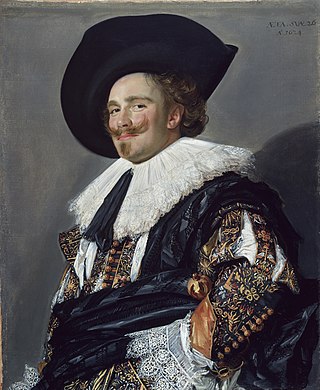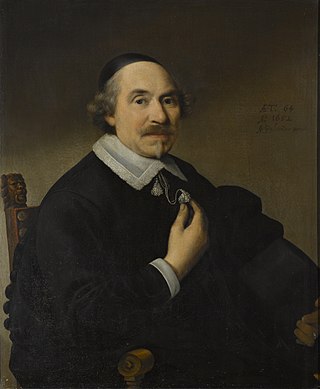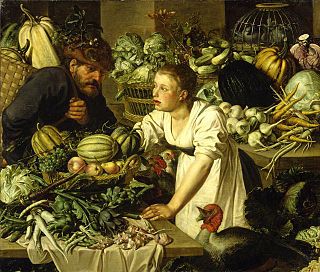

Pieter Biesboer (born 1944), is a Dutch art historian and prolific writer on 17th-century Dutch art. His specialty is art from Haarlem.


Pieter Biesboer (born 1944), is a Dutch art historian and prolific writer on 17th-century Dutch art. His specialty is art from Haarlem.
Biesboer was a curator at Stedelijk Museum het Prinsenhof in Delft during the years 1973-1976. Biesboer became a curator of old masters at the Frans Hals Museum in Haarlem until he retired in 2009, and was succeeded by Anna Tummers. Biesboer's publications include exhibition catalogs and research publications as well as important work for the Getty Research Institute on the Thieme-Becker catalog. After his retirement he began working on the Haarlem pages of the Getty Provenance Index. [1]

Frans Hals the Elder was a Dutch Golden Age painter. He lived and worked in Haarlem, a city in which the local authority of the day frowned on religious painting in places of worship but citizens liked to decorate their homes with works of art. Hals was highly sought after by wealthy burgher commissioners of individual, married-couple, family, and institutional-group portraits. He also painted tronies for the general market.

The Laughing Cavalier (1624) is a portrait by the Dutch Golden Age painter Frans Hals in the Wallace Collection in London. It was described by art historian Seymour Slive as "one of the most brilliant of all Baroque portraits". The title is an invention of the Victorian public and press, dating from its exhibition in the opening display at the Bethnal Green Museum in 1872–1875, just after its arrival in England, after which it was regularly reproduced as a print, and became one of the best known old master paintings in Britain. The unknown subject is in fact not laughing, but can be said to have an enigmatic smile, much amplified by his upturned moustache.

Floris van Dyck, also called Floris van Dijck or Floris Claesz. van Dyck was a Dutch Golden Age still life painter.

Cornelis Corneliszoon van Haarlem was a Dutch Golden Age painter and draughtsman, one of the leading Northern Mannerist artists in the Netherlands, and an important forerunner of Frans Hals as a portraitist.

The Haarlem Guild of Saint Luke was first a Christian, and later a city Guild for various trades falling under the patron saints Luke the Evangelist and Saint Eligius.

Pieter Anthonisz van Bronckhorst or Bronkhorst, was a Dutch painter active in Delft. He was mainly an architectural painter known for his church interiors and fantasy palaces with small figures representing biblical stories. It is possible he also painted still lifes and was a staffage painter for other painters.

Theodorus Schrevelius was a Dutch Golden Age writer and poet.

Pieter Cornelisz van Rijck, was a Dutch Golden Age painter.

Joseph Coymans, was a Dutch businessman in Haarlem, known best today for his portrait painted by Frans Hals, and its pendant, Portrait of Dorothea Berck. The former resides at the Wadsworth Atheneum in Hartford, the latter at the Baltimore Museum of Art. A portrait of the couple's son Willem is held by the National Gallery of Art in Washington, D.C.

Pieter Jacobsz Olycan, was a Dutch brewer, magistrate, and later mayor of Haarlem, best known today for his portraits by Frans Hals, as well as for the portraits of his wife Maritge Claesdr. Voogt.

Tieleman Roosterman, was a Dutch cloth merchant and friend of Willem van Heythuysen. Roosterman is best remembered today for his portrait painted by Frans Hals.

Isabella Coymans, was the Dutch wife of Stephanus Geraerdts best known for her portrait painted by Frans Hals.

Michiel de Wael, was a Dutch brewer and citizen of Haarlem, best known today for his portraits painted by Frans Hals. His grandfather, also a brewer, was one of the first Calvinists in the city and was involved in the Siege of Haarlem.

Gijsbert Claesz van Campen, was a Dutch cloth merchant of Haarlem who is most famous today for his family portrait painted by Frans Hals. The sitters in this painting have been identified by Pieter Biesboer as the family of Gijsbert Claesz. van Campen and is today split into three parts; the left half is in the collection of the Toledo Museum of Art, with an extra baby lower left added by Salomon de Bray in 1628, the center half is in the collection of the Royal Museums of Fine Arts of Belgium, Brussels, and a third fragment on the far right from a European private collection make up the three known surviving pieces of the original portrait. These three segments were reunited at the Toledo Museum of Art for an exhibition October 18, 2018 – January 6, 2019. The exhibition traveled to the RMFAB in Brussels from February 2 – April 28, 2019 and the Collection Frits Lugt in Paris, from June 8 – August 25, 2019.

Lucas de Clercq, was a Dutch cloth merchant known today for his and his wife's pendant marriage portraits painted by Frans Hals.

Aletta Hanemans (1606–1653), was a Dutch brewer. She became the brewer of the Hoeffijser in Haarlem. She is best known today for her marriage portrait by Frans Hals, painted when she married the brewer, magistrate, and later mayor of Haarlem, Jacob Pietersz Olycan in 1624.

Nicolaes van Loo, was a Dutch Golden Age brewer from Haarlem, best known today for his portrait by Frans Hals.
The De Grebber are considered to be one of the oldest noble families in Waterland and the city of Amsterdam.
![]() Media related to Pieter Biesboer at Wikimedia Commons
Media related to Pieter Biesboer at Wikimedia Commons